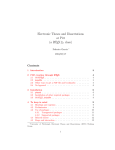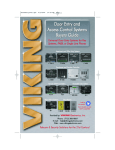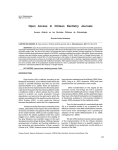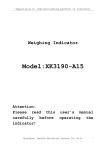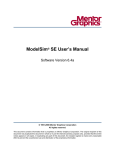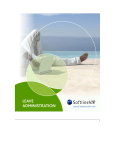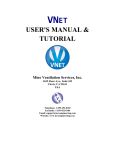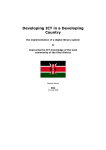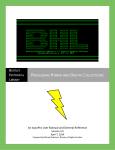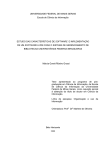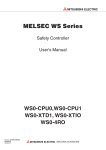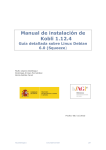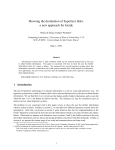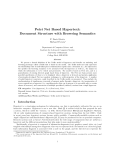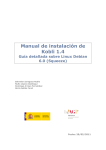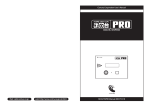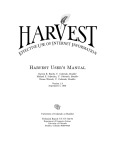Download Get cached
Transcript
Assembling and Enriching Digital Library Collections
David Bainbridge, John Thompson and Ian H. Witten
Department of Computer Science
University of Waikato
Hamilton, New Zealand
{davidb, jmt12, ihw}@cs.waikato.ac.nz
necessary to deal with paper documents and the process
of digitization and OCR [10]; however, we cannot address
these issues here.
The requirement for such a tool originated in the
context of digital libraries for sustainable development
[13]. Effective human development blossoms from
empowerment rather than gifting: as the Chinese proverb
says, “Give a man a fish and he will eat for a day; teach
him to fish and he will eat for the rest of his days.”
Although disseminating information originating in the
developed world is certainly a useful activity, a more
effective strategy for sustained long-term human
development is to disseminate the capability of creating
information collections rather than the collections
themselves. And if we can help inhabitants of developing
countries to assemble their own information collections,
surely we can use the same techniques in our own homes
and institutions too.
The tool that we describe here, called the “Gatherer,”
works in consort with the Greenstone digital library
software [14, 16], and is GPL-licensed open source
software. This makes the work of building it much easier,
for other GPL modules can be incorporated verbatim—
and we have taken full advantage of this. It is
implemented in Java, for portability and efficiency, and
uses the Swing user interface system [4].
This paper begins by identifying the requirements for
assembling and enriching digital library collections, and
then reviews public domain digital library software tools
that help with collection creation. We next describe the
Gatherer by presenting a detailed illustrated walkthrough
of its operation and then expand upon this to describe
how it supports different workflows.
Abstract
People who create digital libraries need to gather
together the raw material, add metadata as necessary,
and design and build new collections. This paper sets
out the requirements for these tasks and describes a new
tool that supports them intera ctively, making it easy for
users to create their own collections from electronic files
of all types. The process involves selecting documents for
inclusion, coming up with a suitable metadata set,
assigning metadata to each document or group of
documents, designing the form of the collection in terms
of document formats, searchable indexes, and browsing
facilities, building the necessary indexes and data
structures, and putting the collection in place for others
to use. Moreover, different situations require different
workflows, and the system must be flexible enough to
cope with these demands. Although the tool is specific to
the Greenstone digital library software, the underlying
ideas should prove useful in more general contexts.
1. Introduction
One attractive feature of digital libraries is that they
make it possible—even easy—to assemble new
anthologies of targeted information, organize them,
provide worldwide access through the Internet, and
distribute them on removable media. Moreover, this can
be accomplished by domain specialists who do not
necessarily have information science training and who
lack the institutional backup of a conventional library
catalog room.
These advantages could be more widely realized if
appropriate support were available for people who create
information collections. Such people, who have been
called “corpus editors” [6], need an interactive tool that
facilitates the entire process of building digital library
collections, and that is what this paper describes. We
assume that the source material is available electronically,
or has already been scanned into digital form. In practice
when building digital library collections it is often
2. Requirements
Our conception of digital libraries is captured by the
following brief characterization [1]:
A collection of digital objects, including text,
video, and audio, along with methods for access
0-7695-1939-3/03 $17.00 © 2003 IEEE
323
Table 1 Implementation summary of sample open source digital library systems
System
URL
Platform
Technology
CDS/ISIS
Harvest
Koha
EPrints
DSpace
www.unesco.org/webworld/isis
harvest.sourceforge.net
www.Koha.org
www.EPrints.org
www.DSpace.org
Windows
Unix
Unix
Unix
Java/Unix
Greenstone
www.greenstone.org
Unix,
Windows,
MaxOS X
Various
C, PERL, Bison, Flex
mySQL, PERL
mySQL, PERL
postgreSQL, Lucene
(indexing)
GDBM, MG (indexing),
PERL (building), C++
(runtime)
and retrieval, and for selection, organization
and maintenance of the collection.
It is the last point—selection, organization and
maintenance—that is addressed in this paper. Our view is
that just as new books acquired by physical libraries are
integrated with the existing catalog on the basis of their
metadata, so one should easily be able to add material to a
digital library without having to edit its content in any
way. Once added, such material should immediately
become a first-class component of the library, fully
integrated with existing search and browsing structures
through explicitly -stated metadata. The challenge is to
provide an easy-to-use interactive interface to help
librarians provide appropriate metadata, and design and
build collections.
The first step in putting together a new information
collection is to gather the source material from local files,
or from the Web, or perhaps from already-existing digital
library collections. These files may be in many different
formats. Furthermore, they may include metadata, perhaps
contained in document files, perhaps in separate metadata
files, or perhaps already embedded in an existing digital
library collection.
Next, it is necessary to select, define, or modify a
metadata set. When importing existing metadata, it may be
necessary to convert between different standards, or
modify an existing metadata schema to include new
elements. Also, it is frequently convenient to be able to
specify metadata for each document interactively.
Sometimes one wishes to assign the same metadata value
to a group of files, or directories, in a single operation.
New element values should be stored so that they can be
re-used by selecting them, to reduce the risk of
introducing errors through retyping.
The next step is to design the collection structure
around the available metadata, build the indexes and
browsing structures, and move the collection to a place
where it can be served to potential users. These
operations tend to be specific to a particular dig ital library
system. In our case, we have used Greenstone as the
underlying digital library infrastructure.
Supported
standards
Z39.50, MARC
Open Archives
Open Archives
Z39.50, Open
Archives , MARC
The extensible nature of open-source software poses
its own difficulties. New modules (“plug-ins” and
“classifiers” in Greenstone terminology; see below) are
self-documenting in that they contain information on the
options and switches they support. This needs to be
garnered automatically and presented to users where
appropriate when they are designing collections.
Building digital library collections inevitably involves
some consideration of workflow. Is the collection built on
a local computer or a central digital library server? If the
latter, do the files originate on the server or the local
workstation from which the digital library is being
acces sed? Or is the material sent to a central collection
editor from one or more remote locations? And if so,
where is the metadata assigned—remotely, centrally, a
combination of both, or produced remotely and checked
and edited centrally?
On the whole, existing systems assume a specific
workflow model that is motivated by the needs of the
intended user base. However, in our work we strive for
greater generality. A range of different workflows can be
accommodated, and we believe that the design is flexible
enough to be used in situations that have not explicitly
been envisaged. For example, in the “remote
submission/central collection” scenario, our system helps
in both roles: preparing metadata that accompanies
documents when they are submitted, and reviewing and
editing submissions before incorporating them into the
collection.
3. Related Work
Recent years have seen a steep rise in the number of
digital library solutions available, and it is impractical to
review them all here. Instead we concentrate on examining
pertinent strategies that have been successfully
deployed. Proprietary systems are not discussed because
insufficient design information is available.
The designers of the digital library systems described
below generally use off-the-shelf technology to
implement significant parts of the system. In particular
324
they use a database (typically relational) to store and
retrieve metadata, and an indexing tool if full-text
searching of document content is to be provided. A web
server capable of running CGI scripts is another widely
used component, because the most prevalent form of
digital library user interface acts through a web browser.
These components are bound together by custom
software that implements the workflow constituting the
digital library system.
Table 1 lists six open source digital library systems, the
last being our own, and summarizes the platforms,
principal implementation technologies, and component
standards.
CDS/ISIS is an information storage and retrieval
system that has been under continual development by
UNESCO since 1985 and is intended, in particular, to
address the requirements of developing countries [3]. It
provides a multilingual text database that is widely used
for storing bibliographic information and distributing it on
CD-ROM, and also for thesaurus management.
Harvest is a system designed to collect information
and make it searchable through a web interface [7]. It has
a module (also called “Gatherer,” but no relation to the
system described here) that extracts metadata from source
documents using a flex parser for pattern matching.
Customizing extraction is, in essence, writing a new set of
flex rules. Extracted metadata is used as a “snippet” to
present to the user when displaying search results.
However, it is not possible to restrict searches to
particular metadata fields.
EPrints is designed for archiving on-line reports,
particularly academic research papers [8, 9]. Indexing and
a subject hierarchy are based around a relational database
of bibliographic metadata that a site administrator can
adjust to suit the sort of reports being stored. Source
documents are linked to their corresponding bibliographic
record so that they can be accessed at runtime as a side product of record retrieval. Through a network of web
pages, end-users (who are often authors of papers in the
archive) and the administrator participate in a workflow
cycle of submission (article and descriptive metadata),
optional editing control, and deposit —thereby
accomplishing the developers’ stated aim of a “selfarchiving” methodology.
Using exactly the same implementation technology,
Koha1 focuses on a different community—public
librarians and their users [2]. The services provided are
strikingly different to those offered by EPrints, but the
underlying techniques are similar. In addition to
bibliographic information (expressed in MARC format) in
the relational database, recorded items are extended to
1
include membership, reading list, acquisition, and budget
information, amongst other things. However, the same
basic arrangement of web forms is used to support a
workflow of submission and editing (password protected
if required). From the user’s perspective, Koha is like the
graphical, web-based OPAC systems one has come to
associate with public libraries.
DSpace, a combined venture by MIT and Hewlett
Packard, targets the digital content needs of institutions
[17]. Strongly influenced by the Open Archival
Information Systems (OAIS) reference model [5], DSpace
supports submission, searching, browsing and retrieval.
Searching includes full-text retrieval, which, through the
use of Apache’s Lucene indexing tool, allows for
incremental updates.
Considerable attention is paid to the submission
workflow. Users wishing to submit items first log into
DSpace, then enter files and associate metadata with them
using a modified Dublin Core schema. On receipt of a
submission, DSpace notifies the following people:
Reviewer, who accepts or rejects the submission
Approver, who checks for file errors, etc.
Editor, who checks and augments metadata.
Once these steps are complete, the submission is
archived into the system, paying particular attention to
the data format and level of preservation.
3.1 Greenstone
Based on the study of the requirements, we have
designed a new piece of software, the Gatherer, which
supports interactive collection building and is closely
coupled with Greenstone. The design has benefited
greatly from our study of other open source digital library
systems, and from our own experience with two existing
Greenstone modules, the Collector [15] and the Organizer
[12]. We have also learned from the “Metadata Editor,” an
independent software module created by a separate
organization that works with Greenstone. We describe
these related systems first before providing an account of
the Gatherer in the next section.
Developed over the last five years, the Greenstone
open source digital library software from the New Zealand
Digital Library project enjoys considerable success and is
widely used [14, 16]. It provides a new way of organizing
information and making it available over the Internet. A
collection of information is typically comprised of several
thousand or several million documents, and a uniform
interface is provided to all documents in a collection. A
library may include many different collections, each
organized differently—though there is a strong family
resemblance in how they are presented. Its strengths
include international language support, multilingual
interfaces, and a flexible document importing process that
The name is a Maori word meaning gift or donation, chosen to
reflect the open source nature of this project.
325
handles different formats—HTML, Word, PDF,
PostScript, and E-mail messages, to name but a few.
Images, video and audio require accompanying textual
metadata.
For the purposes of the present paper it is necessary
to learn a little about three key design features of
Greenstone: plug-ins, classifiers, and the collection
configuration file. In Greenstone, the structure,
organization, and presentation of any particular collection
are determined when the collection is set up. This
includes such things as the format or formats of the
source documents, how they should be displayed on the
screen, the sources of metadata, what browsing facilities
are to be provided, what full-text search indexes are
required, and how the search results should be displayed.
Once the collection is in place, it is easy to add new
documents to it—so long as they have the same format as
the existing documents, and the same metadata is
provided, in exactly the same way. The structure,
organization, and presentation of the collection is
recorded in a text file called the “collection configuration
file.”
Source material is imported into the system through
“plug-ins” that cater for different document formats. Any
given collection may have source documents in many
different forms. There are plug-ins to handle all the file
formats mentioned above, along with some proprietary
formats, and for generic tasks such as recursively
traversing directory structures containing such
documents. Plug-ins can be written to accommodate new
document types.
Greenstone builds browsing indexes from metadata.
This is done using “classifiers,” which are analogous to
plug-ins. Classifiers create browsing indexes of various
kinds, based on metadata—alphabetically tabbed lists (of
titles, for example), date-selected lists, and hierarchical
browsing structures. Like plug-ins, new classifiers can be
written for special-purpose browsing structures.
It is modeled after popular end-user installation software
(such as InstallShield 2). Frequently called a software
“wizard”—a term we deprecate because of its appeal to
mysticism and connotatio ns of utter inexplicability—this
interaction style suits novice users because it simplifies
the choices and presents them clearly.
The Collector is implemented as a web-based system.
A user goes to a certain web address in any Greenstone
installation to find a page that facilitates collection
building. The ability to build collections is protected:
users must log in first, and only those with appropriate
privileges are allowed to build collections. Being webbased imposes certain restrictions. First, there are security
issues with letting remote users transfer files to the site
running the web server. Second, the user’s local file space
is only available in a limited way through the file -upload
mechanism, meaning that only one file at a time can be
specified. Third, web-based interaction was not designed
for lengthy processes such as building digital library
collections (which can take many hours of processor time
for non-trivial collections), and special measures must be
taken to ensure that the user receives appropriate
feedback, and that the right things happen on moving to
another page, or pressing the Back button, while the
collection is being built.
Greenstone is so easy to install and run that, contrary
to the assumptions we made when designing the
Collector, users often work on a local copy of the
software that runs on their own computer. They quite
reasonably expect there to be a convenient mechanism for
populating their collections with local files, which the
Collector cannot do directly.
3.3 The Organizer
One of Greenstone’s early adopters, SimpleWords of
Brasov, Romania, uses it to build and distribute
collections for humanitarian purposes—collections that
share a common collection configuration file but have
different content. Librarians must manually assign a
substantial amount of metadata to each document in the
collection. They do this using a uniform metadata scheme
called the Development Library Set (DLS). However, the
Collector does not provide any interactive way of
specifying metadata to be added to documents. Although
Greenstone accommodates different metadata formats,
including a simple but flexible XML format, OAI, MARC
records, a spreadsheet format, BibTeX, and even Refer, all
metadata must be available in advance, stored in files.
SimpleWords implemented a separate utility, the
Organizer, to create and edit the material associated with a
collection conforming to their humanitarian format [12].
3.2 The Collector
Part of Greenstone, the Collector is a utility for collection
building with the following basic functions [15]:
§ create a new collection with the same structure as an
existing one;
§ create a new collection with a different structure from
existing ones;
§ add new material to an existing collection;
§ modify the structure of an existing collection;
§ delete a collection;
§ write an existing collection to a self-contained, selfinstalling CD-ROM.
2
326
www.installshield.com
Figure 1. Starting a new collection
Figure 2. Exploring the local file
space
This is a Microsoft Visual C++ application, distributed
with Greenstone. It assists in the creatio n of collections
that use DLS.
The Organizer is designed to help manage all aspects
of organizing a digital library collection: entering
document titles, assigning subjects and other metadata,
altering them, etc. It is, however, limited to a particular
document model, and users who wish to add metadata not
included in this model would have to make manual
modifications to the Organizer’s results. Also, because it
is restricted to Windows whereas Greenstone runs under
Unix and MacOS X too, the Organizer is not fully
integrated but works by generating intermediate files that
Greenstone uses when building collections. While this
loose coupling has some advantages in flexibility, it
prevents the full collection-building process from being a
single, integrated, task.
allows users to enter and edit the metadata associated
with a document. This module is used both by people in
the field office when initially entering metadata, and by
the central librarian who checks it. For the former it
incorporates facilities for automatically submitting the
document and metadata to the central office, while for the
latter it makes it easy to periodically rebuild the
Greenstone collections with the new documents.
Although the Metadata Creator is at present restricted
to the Mercy Corps’ own in-house metadata standard,
they are planning to release a Dublin Core version to the
Greenstone community for general usage. Though it will
remain useful as a lightweight metadata entry utility, like
the Organizer it does not provide a tight coupling with the
collection-building process, a serious omission from our
requirements analysis.
4. The Gatherer: Functionality
3.4 The Metadata Creator
The Gatherer allows users to collect sets of
documents, import or assign metadata, and build them
into a Greenstone collection. It differs from the Collector
in that its default behaviour is to work on the computer
running the Greenstone digital library software rather than
building collections on a remote machine, and this permits
a more flexible interface. It differs from the Organizer and
the Metadata Creator in that it deals with unrestricted
metadata sets, and can be tightly integrated with the
Greenstone collection design and creation process.
The Gatherer is written in the Java language and is
platform-independent. It incorporates various opensource packages for such tasks as file browsing, HTML
rendering, web mirroring, and efficient table sorting.
The user works with it to build a Greenstone collection.
It supports five basic activities, which can be interleaved
but are nominally undertaken in this order:
1. Copy documents from the computer’s file space,
including existing collections, into the new collection.
Another organization, the Mercy Corps, centered in
Portland Oregon and with operations in about thirty of
the world’s most unstable countries, uses Greenstone to
organize its extensive collection of in-house documents,
manuals, forms, and memos. They have made significant
enhancements to support a workflow for new acquisitions
to the library.
In their organization, field offices submit new
documents by filling out metadata using a simple webbased form and attaching the document. This arrives in
the in-tray of a central librarian who checks it for
correctness and integrity before including it in the
appropriate collection. Collections, rebuilt automatically
every night, are available on the web for in-house use,
and are written at regular intervals to CD-ROM for
physical distribution.
Mercy Corps designed and implemented the Metadata
Creator, an interactive web-based database system that
327
Figure 3. Importing existing metadata
2.
3.
4.
5.
Figure 4. Filtering the file trees
Any existing metadata remains “attached” to these
documents. Documents may also be gathered from the
web through a built-in mirroring facility.
Enrich the documents by adding further metadata to
individual documents or groups of documents.
Design the collection by determining its appearance
and the access facilities that it will support.
Build the collection using Greenstone.
Preview the newly created collection.
one. Figure 1 shows the user in the process of starting a
new collection. She has selected New from the file menu
and begun to fill out general information about the
collection—its name, the E-mail address of the person
responsible for it, and a brief description of the content—
in the popup window. The collection name is a short
phrase used throughout the digital library to identify the
collection’s content: existing collections have names like
Food and Nutrition Library , World Environmental
Library, and so on. The E-mail address specifies the first
point of contact for any problems encountered with the
collection. If the Greenstone software detects a problem, a
diagnostic report is sent to this address.
The brief description is a statement describing the
principles that govern what is included in the collection. It
appears under the heading About this collection on the
collection’s initial page. Lesk [11] recommends that digital
libraries articulate both the principles governing what is
included and how the collection is organized. About this
collection is designed to address the first point.
Greenstone takes care of the second using help text,
which is formed by automatically generating a list of
access mechanisms based on the searching and browsing
facilities that are included in the collection.
At this point, a metadata set is selected. Dublin Core is
pre-supplied, but the user can create new metadata using
a popup panel activated through the “metadata” menu.
This has already been done for the DLS metadata set
mentioned above, and the user has chosen this item for
her new collection. Several different metadata sets can be
associated with the same collection; the system keeps
them distinct (so that, for example, documents can have
both a Dublin Core Title and a DLS Title). Behind the
scenes, metadata sets are represented in XML.
After clicking the OK button on the “new collection”
popup, the remaining parts of the interface, which were
grayed out before, become active. The Gather panel,
selected by the eponymous tab near the top of Figure 1, is
4.1 Assembling the source material
To convey the operation of the Ga therer we work
through a simple example. Figures 1 to 12 are screen
snapshots at various points during the interaction. This
example uses documents in the Humanity Development
Library Subset collection, which is distributed with
Greenstone. For expository purposes, the walkthrough
takes the form of a single pass through the steps listed
above. A more realistic pattern of use, however, is for
users to switch back and forth through the various stages
as the task proceeds.
Since Greenstone is a lightweight system that can
easily be installed on small workstations or laptops, we
have decided to focus on the situation where the
collection editor works interactively on the same
computer where collections are built. However, it is
possible to use the Gatherer to collect document files and
define interaction locally, without a digital library
installation, and send them to a central location for
building into a collection and serving on the Internet. At
the central location a librarian can also use the Gatherer
when deciding whether the documents are suitable to be
added to the collection, and to check and edit the
metadata that has been associated with them. This affords
a degree of flexibility for different workflow requirements.
To commence interaction with the panels, the user
must either open an existing collection or begin a new
328
Figure 5. Assigning metadata using the
Enrich view
displayed initially. This allows the user to explore the
local file space and existing collections, gathering up
selected documents for the new colle ction. The panel is
divided into two sections, the left for browsing existing
structures and the right for the documents in the
collection.
Operations available at this stage include:
§ Navigating the existing file structure hierarchy, and
the one being created, in the usual way.
§ Dragging and dropping files into the new collection.
§ Multiple selection of files.
§ Dragging and dropping entire sub-hierarchies.
§ Deleting documents from the nascent collection.
§ Creating new sub-hierarchies within the collection.
§ Filtering the files that are visible, in both the local file
system and the collection, based on predetermined
groups or on standard file matching terms.
§ Invoking the appropriate program to display the
contents of a selected file, by double-clicking it.
Care is taken to deal appropriately with name clashes
when files of the same name in different parts of the
computer’s directory structure are copied into the same
folder of the collection.
In Figure 2 the user is using the interactive file tree
display to explore the local file system. At this stage, the
collection on the right is empty; the user populates it by
dragging and dropping files of interest from the left to the
right panel. Such files are “copied” rather than “moved”:
so as not to disturb the original file system. The usual
techniques for multiple selection, dragging and dropping,
structuring the new collection by creating subdirectories
(“folders”), and deleting files from it by moving them to a
trashcan, are all available. Through an extra panel, which
can optionally be activated, the user can browse external
Web sites and selectively mirror them; the result of this
copying appears as another top -level folder on the lefthand side of the Gather panel.
Figure 6. Viewing all metadata assigned
to selected files
Existing collections are represented by a subdirectory
on the left called “Greenstone Collections,” which can be
opened and explored like any other directory. However,
the documents therein differ from ordinary files because
they already have metadata attached, which the Gatherer
preserves when it moves them into the new collection.
Conflicts may arise because their metadata may have been
assigned using a different metadata set from the one in
use for the new collection, and the Gatherer helps the user
resolve these. In Figure 3 the user has selected some
documents from an existing collection and dragged them
into the new one. The popup window explains that the
metadata element Publisher cannot be automatically
imported, and asks the user to either select a metadata set
and press Add to add the metadata element to that set, or
choose a metadata set, then an element, and press Merge
to effectively rename the old metadata element to the new
one by merging the two. Metadata in subsequent
documents will automatically be handled in the same way.
When large file s ets are selected, dragged, and
dropped into the new collection, the copying operation
may take some time —particularly if metadata conversion
is involved. To indicate progress, the Gatherer shows
which file is being copied and what percentage of files
has been processed. The implementation is multithreaded: the user can proceed to another stage while
copying is still in progress.
Special facilities are needed for dealing with large file
sets. For example, the user can choose to filter the file tree
to show only certain files, using a dropdown menu of file
types displayed underneath the trees. In Figure 4, only
the HTM and HTML files are being shown (and only
these files will be copied by drag and drop).
Another source of documents is the web itself. The
Gatherer has a Mirror panel that allows the user to
interact with a mini web browser and select certain pages,
or sites, for mirroring. There are many options: mirroring
depth, automatically download embedded objects like
329
images, only mirror from the same site, etc. The actual
download operation is accomplished by wget, a widely used open-source mirroring utility.
and directories.
For our walkthrough example, in Figure 5 the user has
selected the document ac01ne.htm and assigned “The
Courier” as its Magazine metadata. The buttons for
updating and removing metadata become active
depending on what selections have been made.
During the enrichment phase, or indeed at any other
time, the user can choose to view all the metadata that has
been assigned to documents in the collection. This is
done by selecting Metadata from the main menu bar,
which brings up a popup window like that in Figure 6 that
shows the metadata in spreadsheet form. For large
collections it is useful to be able to view the metadata
associated with certain document types only, and if the
user has specified a file filter as mentioned above, only
the selected documents are shown in the metadata
display.
The panel in Figure 7 allows the user to edit metadata
sets. Here, the user is looking at the Subject element of
the DLS set. The values of this element form a hierarchy,
and the user is examining, and perhaps changing, the list
of values assigned to it. The same panel also allows you
to change the “profile” for mapping elements of one
metadata set to another. This profile is created when
importing documents from collections that have preassigned metadata.
4.2 Enriching the documents
The next phase in collection building is to enrich the
documents by adding metadata. The Enrich tab brings up
a new panel of information (Figure 5), which shows the
document tree representing the collection on the left and
on the right allows metadata to be added to individual
documents, or groups of documents.
Documents that are copied during the first step come
with any applicable metadata attached. If a document is
part of a Greenstone collection, previously defined
metadata is carried over to the new collection. Of course,
this new collection may have a different metadata set, or
perhaps just a subset of the defined metadata, and only
metadata that pertains to the new collection’s set is
carried over. Resolution of such conflicts may require
user intervention via a supplementary dialog (Figure 3).
Any choices made are remembered for subsequent file
copies.
The Enrich panel allows the metadata set in use for the
collection to be edited. For example, new elements can be
added, or new values can be added to the set of existing
values for an element. If the element’s values have a
hierarchical structure, the hierarchy can be edited using
the same editor that is used when editing the metadata
set.
Operations at this stage include:
§ Assigning new and existing metadata values to
documents.
§ Assigning metadata to an individual document or to a
directory of documents (including nested documents).
§ Assigning hierarchical metadata, whose structure can
be dynamically updated if required.
§ Editing or updating assigned metadata.
§ Reviewing the metadata assigned to a selection of files
4.3 Designing the collection
The Design panel (Figures 9–10) allows one to specify
the structure, organization, and presentation of the
collection being created. As noted earlier, the result of
this process is recorded in a “collection configuration
file,” which is Greenstone’s way of expressing the
facilities that a collection requires. This step involves a
series of separate interaction screens, each dealing with
one aspect of the collection design. In effect, it serves as
a graphical equivalent to the usual process of editing the
configuration file manually.
330
Figure 7. Editing the metadata set
Figure 8. Designing the collection
Operations include:
§ Reviewing and editing collection-level metadata such
as title, author and public availability of the collection.
§ Defining what full-text indexes are to be built.
§ Creating sub-collections and having indexes built for
them.
§ Adding or removing support for predefined interface
languages.
§ Constructing a list of plug-ins to be used, and their
arguments.
§ Presenting the list to the user for review and
modification.
§ Configuring individual plug-ins.
§ Constructing a list of “classifiers,” their arguments,
assignment and configuration.
§ Assigning formatting strings to various controls
within the collection, thus altering its appearance.
§ Reviewing the metadata sets, and their elements, used
in the collection.
In Figure 8 the user has clicked the Design tab and is
reviewing the general information about the collection,
entered when the new collection was created. On the left
are listed the various facets that the user can configure:
Indexes, Subcollections, Languages, Plug-ins, Classifiers,
Format Settings, and Metadata Sets. Appearance and
functionality varies between these. For example, clicking
the Plug-in button brings up the screen shown in Figure
9, which allows you to add, remove or configure plug-ins,
and change the order in which the plug-ins are applied to
documents.
Both plug-ins and classifiers have many different
arguments or “options” that the user can supply. The
dialog box in Figure 10 shows the user specifying
arguments to some of the plug-ins. The grayed-out fields
become active when the user adds the option by clicking
the tick-box beside it. Because Greenstone is a continually
growing open-source system, the number of options
tends to increase as developers add new facilities. To
help cope with this, Greenstone has a “plug-in
information” utility program that lists the options
available for each plug-in, and the Gatherer automatically
invokes this to determine what options to show. This
allows the interactive user interface to automatically keep
pace with developments in the software.
4.4 Building the collection
The Build panel (Figure 11) is to construct a collection
based on the documents and assigned metadata. The
brunt of this work is borne by the Greenstone code itself
(which must be installed for the Gatherer to perform this
step). The user controls this external process through a
series of separate interaction screens, each dealing with
the arguments provided to a certain stage of the creation
process.
The user observes the building process though a
window that shows not only the text output generated by
Greenstone’s importing and index-building scripts, but
also progress bars that indicate the overall degree of
completion of each script.
Figure 11 shows the Create view. On the left are
shown groups of options that can be applied during the
creation process: General, Import, Build, All, MessageLog. The user selects appropriate values for the options.
This figure illustrates a popup “tool tip” that is
available throughout the Gatherer to explain the function
of each argument. In this case the user is selecting the
verbosity level for the collection creation process, and the
tool tip advises that this is a number between zero and
three that controls how much information about the
process is printed to the standard error stream—0 gives a
little, 3 gives lots.
When satisfied with the arguments, the user clicks
Build Collection . Greenstone programs continually print
text that indicates progress, and the Gatherer shows
these, along with a more informative progress bar.
331
Figure 9. Specifying which plug-ins to
use
Figure 10. Configuring the arguments to
a plug-in
Suppose the Gatherer is configured to show the first
two panels (Gather and Enrich) at remote sites and the
last four (Enrich, Design, Create, Preview) at a central
server (where Greenstone is also installed), and data
exchange is activated using the file-export menu option.
This gives the same workflow as that used by Mercy
Corps’ Metadata Creator (Section 3.4). The metadata
(Enrich) panel occurs in both the remote and central
configurations, permitting remote users to enter metadata
and a central librarian to make editorial corrections. For
maximum flexibility the remote site version could be
packaged an applet delivered from the central site that
used a certificate to request permission to access the
remote user’s local file system. EPrints’ submission
process can be a ccomplished using the same mechanism.
Since the Gatherer supports different metadata sets, it
could be used in both of these very different application
contexts.
Configuring the Gatherer to include web mirroring
support provides comparable abilities to Harvest. Two
new panels appear when this option is switched on. The
first is used to browse the web. Once a page, set of pages
or site of interest has been located, the “mirror” panel is
used to control what is downloaded. This naturally flows
onto the Gather panel, already discussed, where material
is selected for inclusion in a collection.
Dispensing with the Gather and Enrich panels allows
catalog-only datasets (produced using, for example,
CDS/ISIS) to be incorporated by specifying the
appropriate plug-in in the Design panel. Alternatively
these panels can be switched back in and the file-import
menu used instead. This allows individual records within
the catalog to be viewed and edited in the Enrich panel.
Providing the functionality of a regular library catalog
system like Koha is more challenging because additional
infrastructure needs to be included in Greenstone.
Despite the very different context, this could be
accomplished using Greenstone’s extensible system of
4.5 Previewing
The Preview panel (Figure 12) is to view the collection
that has been built. The Gatherer provides a preview in a
panel that looks just like a web browser. In practice,
previewing often shows up deficiencies in the collection
design, or in the individual metadata values, and the user
frequently returns to earlier stages to correct these. This
tab becomes active once the collection has been created.
4.6 Help
The Gatherer incorporates extensive on-line help,
which is invoked using the Help item at the right of the
main menu bar at the top of each of the Figures. This
opens up a hierarchically structured file of help text, and
account is taken of the user’s current context to highlight
the section that is appropriate to the present stage of the
interaction. Furthermore, as noted above, whenever the
mouse is held still over any interactive object a small
window pops up to give a textual “tool tip,” as illustrated
in Figure 11.
5. Configurability
Each system reviewed under “Related work” in Section
3 adopts a particular style of workflow, a natural
consequence of the focused application domain that
motivated the project. However, our requirements include
the more ambitious goal of supporting multiple workflow
styles. This is accomplished through a “preferences”
screen that allows users to choose which panels appear.
Panels can be activated or deactivated according to the
desired work flow, which—in combination with importing
and exporting options—adjusts the entry and exit points
of the interactive process. Here are some examples.
332
Figure 11. Getting ready to create the
new collection
plug-ins and classifiers. Custom plug-ins would be
required to manipulate the relevant kind of datasets. Each
Koha database would be viewed as a Greenstone
“collection,” and each item in it as a document with
metadata.
For example, library membership information could be
accessed by building a collection whose documents are
personal records with metadata that records their name,
membership number, and books borrowed. Then the
Gatherer can be used to operate and maintain the system.
Data is entered and edited through the Enrich panel, and
users change collection to switch to a different database.
Figure 12. Previewing the newly built
collection
international users. The name “Gatherer” was coined to
describe a much earlier version of the design and is
somewhat inappropriate now: ultimately this will probably
become known simply as the librarian’s interface to
Greenstone.
Although the Gatherer is tightly integrated into the
Greenstone system, it is possible to run the early stages
of document gathering and metadata editing without
Greenstone being installed on the user’s computer. This
allows many different workflow configurations (for
example, remote users, central librarian) and also raises
the possibility of exporting documents and metadata for
other digital library systems. One of the strengths of the
Gatherer is its ability to use “Preferences” selections to
emulate workflow models built into other systems.
Different users of digital libraries, naturally, have
different needs. While access and retrieval is an obvious
requirement, and dominates digital library research, we
believe that end-user collection creation is another
important element that deserves careful attention and
further development. Including this capability in digital
library systems will help them move away from the large
and mostly static entities currently seen, and evolve into
more dynamic and responsive environments.
The Gatherer represents a significant enhancement to
Greenstone. Although it is specific to this particular
digital library software, we hope that the ideas show how
such an interface can be applied more widely to provide
interactive collection-building facilities in other digital
library systems.
6. Conclusion
The goal of the Gatherer is to provide an interactive
environment for collection editors who build digital library
collections using Greenstone. We have identified the
requirements for such a system. Prominent amongst these
are the need to be able to recruit documents into the
collection from a variety of sources; the ability to assign
metadata sets, modify them if necessary, and assign
metadata to documents interactively; and the process of
designing, configuring, building, and testing the
collection itself. Other requirements include
• creating and editing metadata
• being able to work with different metadata sets
• capability of assimilating new features of Greenstone
(plug-ins and classifiers) without the need for
specific program modifications.
The Gatherer has been designed to satisfy these
requirements. It guides the user step by step through the
process of defining and building a digital library
collection. Although formal user studies have yet to be
undertaken, informal user trials indicate that it provides an
environment for collection-building that is superior to
anything previously available. We are currently in the
process of establishing field trials with several
Acknowledgements
Greenstone is the work of a great many people and we
gratefully acknowledge the contributions of them all, and
in particular the stimulating research environment in the
Digital Library Lab at Waikato. We are also grateful to the
333
anonymous reviewers for helping us to focus our
message.
[8]
Harnad, S. & Carr, L. (2000) “Integrating, navigating, and
analysing open Eprint archives through open citation
linking (the OpCit project)” Current Science, Vol. 79,
No.5, pp. 629-638.
[9]
Hitchcock, S., Carr, L., Jiao, Z., Hall, W. and Harnad, S.
“Developing Services for Open E-Print Archives:
Globalisation, Integration and the Impact of Links.” Proc.
ACM Digital Libraries Conference, San Antonio, Texas,
2000, ACM Press: New York.
References
[1]
Akscyn, R.M. and Witten, I.H. (1998) “Report on First
Summit on International Cooperation on Digital
Libraries.” ks.com/idla-w p-oct98.
[2]
Blake, R. and Hamilton-Williams, R. (2000) “The Koha
story.” http://koha.org/about/story.html.
[10] Kenney, A.R. and Rieger, O.Y. (2000) Moving theory into
[3]
Buxton, A. and Hopkinson, A. (2001) The CDS/ISIS for
Windows Handbook . UNESCO, Paris, September.
practice: digital imaging for libraries and archives.
Research Libraries Group, Mountain View, CA.
[4]
Cole, H., Eckstein, R., Elliott, J., Loy, M. and Wood, D.
(2002) Java Swing. O’Reilly and Associates.
[11] Lesk, M. (1997) Practical digital libraries . San Francisco,
Consultative Committee for Space Data Systems
(CCSDS) (2002) Reference model for an Open Archival
Information System (OAIS). CCSDS 650.0-B-1 Blue
Book, Washington, DC.
[12] Loots, M., Carmazan, D. and Witten, I.H. (2002) “From
Crane, G. and Rydberg-Cox, J.A. (2000) “New
technology and new roles: the need for ‘corpus editors’.”
Proc Digital Libraries 2000, San Antonio, Texas, pp.
252–253.
(2002) “The promise of digital libraries in developing
countries.” The Electronic Library, Vol. 20, No. 1, pp. 713.
[5]
[6]
[7]
CA: Morgan Kaufmann.
paper to collection.” Greenstone Digital Library software
manual, available at greenstone.org.
[13] Witten, I.H., Loots, M., Trujillo, M.F. and Bainbridge, D.
[14] Witten, I.H., McNab, R.J., Boddie, S.J. and Bainbridge,
D. (2000) “Greenstone: A comprehensive open-source
digital library software system.” Proc Digital Libraries
2000, San Antonio, Texas, pp. 113–121.
Hardy, D.R., Schwartz, M.F. and Wessels, D. (1996)
Harvest 1.4 User’s Manual. Technical Report CU-CS743-94, University of Colorado. Revised by K.-J. Lee in
2002 for Harvest version 1.8.
[15] Witten, I.H., Bainbridge, D. and Boddie, S.J. (2001)
“Power to the people: end-user building of digital library
collections.” Proc Joint Conference on Digital Libraries,
Roanoke, VA, 94-103; June.
[16] Witten, I.H. and Bainbridge, D. (2003) How to build a
digital library. Morgan Kaufmann, San Francisco.
[17] Wolpert, A.J. (2002) “The future of electronic data.”
Nature Vol. 420, pp. 17-18.
334












